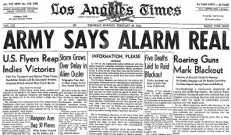
America’s WWII home front had its terrors and dark moments. But Americans soldiered on anyway. That’s what our special issue WWII Mysteries and Mayhem is all about.
By Jim Kushlan
Have you ever told a story that you find hilarious or amazing, only to see your audience stare back at you blankly, expressionless, utterly unmoved? Perhaps you blushed a little, mumbled “I guess you had to be there…,” and moved on.
Sometimes, when we dive into history and immerse ourselves in a bygone era, we’re the ones left standing there blank, expressionless, and utterly unmoved, because we don’t fully “get” the culture and people of the past. I ran into that problem years ago while working for a magazine about the American Civil War. I just didn’t get most mid-19th-century humor.
Looking through popular periodicals of the era, I’d run across a cartoon or perhaps a joke. Even though I had crammed my head with period jargon and expressions and endless information about the era, I never saw anything remotely amusing about those Victorian attempts at humor. I just didn’t share the 19th century’s cultural framework.
Working with World War II material, I run into that a lot less. I do get the jokes and cultural references. After all, my mom and dad were WWII people. Folks then looked, dressed, and spoke much like we do (at least a lot more than people of the 1800s did). Even so, there are things that don’t come across at first, nuances we don’t catch without lots of research, because we weren’t there in the midst of those turbulent times and life-altering events.
Putting together this special issue—WWII Mysteries and Mayhem—took me a long way toward understanding an unspoken but important and ever-present reality of the American WWII home front: fear. We all know the WWII generation to have been plucky, brave, hardworking, ready to make sacrifices. But underlying everything, every day, was fear.
There was fear that loved ones serving overseas might not return, or might return broken or forever changed. There was fear that Axis enemies might attack on US soil via air raids, submarines, ground invasion, or secret agents and saboteurs. The government reinforced this fear, requiring civilians to black out their windows at night so enemy aircraft wouldn’t be able to detect US towns. By day, trained civilian plane-spotters across the States scanned the skies, identifying every plane by its silhouette so they could report any enemy incursion. Meanwhile, government posters warned that spies were everywhere.
Home-front fear inspired great efforts and sacrifices. It also inspired ugly things, like the internment of Japanese, German, and Italian Americans. And for better or worse, it would shape US domestic and international policy to one degree or another for decades.
This special issue is a sampler of things that kept WWII Americans on edge. It is by no means exhaustive. But I think it provides important context to help us better understand and connect with the people of the WWII home front. They helped fight and win the war through their industrial production, volunteerism, financial support, and sacrifice—and through their prayer and support for the military personnel overseas. Knowing they did all that with fear gnawing relentlessly at their souls makes me admire them all the more.
Jim Kushlan is the publisher of America in WWII magazine.



FOLLOW US »
